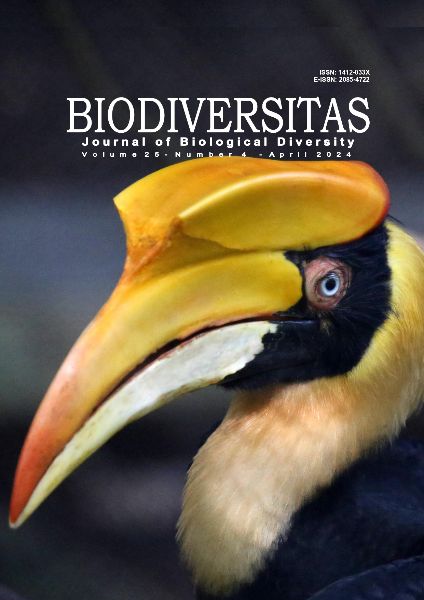Profile of chemical compounds and potency of galangal (Kaempferia galanga L.) essential oils from Kemuning Village, Karanganyar District, Central Java, Indonesia
##plugins.themes.bootstrap3.article.main##
Abstract
Abstract. Muzzazinah, Yunus A, Rinanto Y, Suherlan Y, Ramli M, Putri DS, Ningtyas DW, Rahma AL, Nabila SJ. 2024. Profile of chemical compounds and potency of galangal (Kaempferia galanga L.) essential oils from Kemuning Village, Karanganyar, Central Java, Indonesia. Biodiversitas 25: 1386-1393. Kencur or galangal (Kaempferia galanga L.) belongs to the Zingiberaceae family, which is known to contain essential oils. K. galanga essential oil is commonly used as a traditional medicine, one of which is to treat inflammation. This study aims to analyze the chemical content of the essential oil of K. galanga from Kemuning Village and their known bioactivities. The material used was essential oil from the distillation of K. galanga rhizome, which is the waste product of Kemuning essential oil production. Gas Chromatography-Mass Spectrometry (GC-MS) was applied to analyze the chemical content of K. galanga essential oil. The results showed that the phytochemical content of K. galanga essential oil compounds were Pentadecane: 36.64%, Cyperene: 1.16%, Alpha-gurjunene: 1.04%, Heptadecane: 1.24%, 8-Heptadecane: 1.68%, Gamma-Muurolene: 1.55%, (2,2)-3,6-Nonadienal: 2.41%, Ethyl (2E), 3-Phenyl-2-Propenoate: 16.02 %, Ethyl P-Methoxycinnamate: 6.36%, and Ethyl P-Methoxycinnamate: 25.54%. This study shows that K. galanga is a good source of phytoconstituents used as industrial raw materials to produce medicines, perfumes, and flavoring ingredients.
##plugins.themes.bootstrap3.article.details##
Most read articles by the same author(s)
- SRI HARTATI, NANDARIYAH NANDARIYAH, AHMAD YUNUS, DJATI W. DJOAR, Short Communication: Cytological studies on black orchid hybrid (Coelogyne pandurata Lindley) , Biodiversitas Journal of Biological Diversity: Vol. 18 No. 2 (2017)
- DWI FAJAR SIDHIQ, YULI WIDIYASTUTI, DYAH SUBOSITI, BAMBANG PUJIASMANTO, AHMAD YUNUS, Morphological diversity, total phenolic and flavonoid content of Echinacea purpurea cultivated in Karangpandan, Central Java, Indonesia , Biodiversitas Journal of Biological Diversity: Vol. 21 No. 3 (2020)
- JESSYCA PUTRI CHOIRUNNISA, YULI WIDIYASTUTI, AMALIA TETRANI SAKYA, AHMAD YUNUS, Morphological characteristics and flavonoid accumulation of Echinacea purpurea cultivated at various salinity , Biodiversitas Journal of Biological Diversity: Vol. 22 No. 9 (2021)
- WINA CHANDRA FERDYANA, YULI WIDIYASTUTI, BAMBANG PUJIASMANTO, AMALIA TETRANI SAKYA, AHMAD YUNUS, Short Communication: Morphological diversity and the addition of golden snail protein: Its effect on flavonoid content on Echinacea purpurea , Biodiversitas Journal of Biological Diversity: Vol. 23 No. 1 (2022)
- ZULFAHMI, PARJANTO, EDI PURWANTO, AHMAD YUNUS, Genetic diversity and population structure of Eurycoma apiculata in Eastern Sumatra, Indonesia , Biodiversitas Journal of Biological Diversity: Vol. 22 No. 10 (2021)
- EMI SUSILA, ARI SUSILOWATI, AHMAD YUNUS, The morphological diversity of Chrysanthemum resulted from gamma ray irradiation , Biodiversitas Journal of Biological Diversity: Vol. 20 No. 2 (2019)
- MUZZAZINAH, SURATMAN, NURMIYATI, SRI RETNO DWI ARIANI, Morphological and anatomical characters variation of Indigofera accessions from Java, Indonesia , Biodiversitas Journal of Biological Diversity: Vol. 22 No. 4 (2021)
- MARIA SERVIANA DUE, ARI SUSILOWATI, AHMAD YUNUS, The effect of gamma rays irradiation on diversity of Musa paradisiaca var. sapientum as revealed by ISSR molecular marker , Biodiversitas Journal of Biological Diversity: Vol. 20 No. 5 (2019)
- ZULFAHMI, EDI PURWANTO, PARJANTO, AHMAD YUNUS, Phenotypic diversity and plasticity index of Eurycoma apiculata populations in Eastern Sumatra, Indonesia based on leaves morphology , Biodiversitas Journal of Biological Diversity: Vol. 21 No. 7 (2020)

